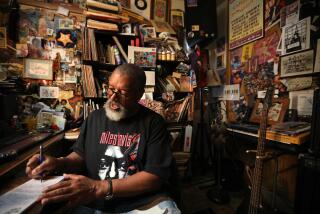Farewell to Clay Felker’s brand of N.Y. cool
- Share via
According to everyone, Clay Felker’s New York magazine was the best. “Clay Felker’s New York” is a phrase that refers to a man (who died Tuesday from throat cancer at age 82, at his home in Manhattan) and the magazine he started and edited -- first in 1964 as a Sunday supplement to the New York Herald Tribune and then relaunched on its own in 1968 with Felker’s last dime at the time, until Rupert Murdoch wrested it from him in a 1977 takeover.
It could also be about a place that is always in a state of vanishing, a New York City before everyone caught on, a New York in the throes of constant reinvention and trendification, a place where the idea of radical chic was born and so was the national cult of Ken Kesey and so was a case of Saturday Night Fever. Clay Felker’s New York was a magazine written and designed by and for the coolest people who ever lived, and, to the degree that they’re still around, they’ll never let you forget it.
No discussion of the eternal heartbreak of making magazines is complete without a reverent nod to Felker and his New York. (And his Manhattan, inc., and his stints at Esquire and his go-around with the Village Voice; and his birthing of New West in vibey California; and in any magazine, past or present, that consciously reaches for a Felker-like combination of thoroughly hip and thoroughly helpful.)
Anyone who ever tried to save a magazine from going under appreciated the golden era of Felker -- including Felker, who rode several magazines into the ground after he left New York, including the Eastside Express and Manhattan, inc. Anyone who ever had to fact-check the “Best Restaurants” issue or the “Summer Weekends” issue appreciated Felker, even though service journalism can be a complete drag to make happen; it’s the magazine lawn that always needs mowing, whether you’re at New York magazine or Atlanta magazine or D magazine -- and they’re all still doing it; never have American magazine readers been more serviced.
Anyone who ever had an 8,000-word piece cut to 1,500 words could always find wistful consolation in a moldered Tom Wolfe anthology, made up of extremely long magazine pieces, many of them edited by Felker or produced in the contagiously exciting era of New Journalism. (“It’s a misnomer, and it’s a term I don’t like,” Felker told Charlie Rose in 1995 in reference to what his friend Wolfe promoted as the “New Journalism.” What’s so new about telling a story right, Felker wondered, with all the details, with the great dialogue from fully fleshed-out characters, with a sense of what it all means?)
Here was the magazine -- and the editor, and the movement -- that aided the Manhattan-centric discovery of feminism, of counterculture as a marketed lifestyle, of the style of telling us about the latest style. (Gail Sheehy, who married Felker, on women in singles bars, for example, in an early issue of New York in the mid-’60s: “Booted, pant-suited, birth-controlled and pleasure-goaled.”)
Clay Felker’s New York is a wall you run smack into, even now, if you sit down and try to type anything true, factually reported, and at a length longer than your own editor hopes for. Once you’ve blown that, there’s the packaging to contend with, which Felker and company also honed to an exact science, what they call the display -- the right art, the right head, the right pull-quotes, the right spread.
These are things readers don’t care about.
Except you do care, if you like magazines. You, sir, headed to the can with the new Sports Illustrated under your arm. You, ma’am, lost in a Vanity Fair on the elliptical trainer. You, in Seat 24C with your airport spree of the Atlantic, Esquire and Vibe.
People talk a lot about how magazines are doomed, how they always seemed better in some other previous permutation, and yet the love affair goes on. Just picking up a magazine, examining its cover, letting its subscription cards fall out onto the floor -- something still works. Look at all those men who linger in the magazine aisles at the Borders during weekday lunch hours. There’s this eternal hope in a new issue of a magazine. You don’t have to read it. You absorb it, take it to bed with you.
That, followed by the very essence of magazinedom: where to buy this stuff, what’s the very latest, who’s the very smartest, which doctor should lift your eyes, what’s the best steak in town. Felker cared about that just as much as the long narrative.
Now Clay Felker is a journalism school, or at least a name and an inspiration for part of a journalism school -- the Felker Magazine Center at UC Berkeley. He’s a method, a way, described in the odd, passive language of course catalogs, on the school’s website: “Narrative voice, point of view, extended dialogue, character development, story structure, scene construction, and personal style are some of the things that distinguish good, long-form magazine writing. What makes the J-School program so special is how we teach these building blocks of long-form magazine and newspaper feature writing and editing.” (All this, at only $47,000 a year!)
Appreciate Clay Felker? It’s all anyone ever did, who wanted anything to do with magazines. Was it emulation, was it envy, or was it a fantasy -- working for the perfect place, the perfect editor, at the perfect time?
“We knew who we were aiming at -- we were aiming at ourselves,” Felker told TV host Rose in that same interview. “It was a group of young editors and writers and art directors in their 20s and 30s, and so we were putting out a magazine for what interested us. It sounds awfully selfish, but that really is the best way to do something.”
Nowadays a focus group will tell you that’s the worst way to put out a magazine and still expect people to buy it. Now it’s about what the reader wants and only what the reader wants. (Shorter articles! More lists!) Felker understood that a magazine makes you feel cool. It validates you by being cool, which means you must also be cool just for reading it. Now that sort of attitude strikes many readers as condescending, or God forbid, snarky.
Now it seems like magazines try to teach you to be cool. And that’s so uncool.


